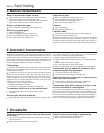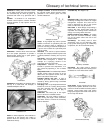
Fault finding REF•15
REF
2 Cooling system
3 Fuel and exhaust systems
Overheating
ⅥⅥ Insufficient coolant in system (“Weekly checks” ).
ⅥⅥ Thermostat faulty (Chapter 3).
ⅥⅥ Radiator core blocked, or grille restricted (Chapter 3).
ⅥⅥ Electric cooling fan or thermoswitch faulty (Chapter 3).
ⅥⅥ Pressure cap faulty (Chapter 3).
ⅥⅥ Ignition timing incorrect/ignition system fault (Chapters 1 and 5B).
ⅥⅥ Inaccurate temperature gauge sender unit (Chapter 3).
ⅥⅥ Airlock in cooling system (Chapter 1).
Overcooling
ⅥⅥ Thermostat faulty (Chapter 3).
ⅥⅥ Inaccurate temperature gauge sender unit (Chapter 3).
External coolant leakage
ⅥⅥ Deteriorated or damaged hoses or hose clips (Chapter 1).
ⅥⅥ Radiator core or heater matrix leaking (Chapter 3).
ⅥⅥ Pressure cap faulty (Chapter 3).
ⅥⅥ Coolant pump seal leaking (Chapter 3).
ⅥⅥ Boiling due to overheating (Chapter 3).
ⅥⅥ Core plug leaking (Chapter 2D).
Internal coolant leakage
ⅥⅥ Leaking cylinder head gasket (Chapter 2A, 2B or 2C).
ⅥⅥ Cracked cylinder head or cylinder bore (Chapter 2A, 2B, 2C
or 2D).
ⅥⅥ Leaking cylinder liner base seal (Chapter 2D)
Corrosion
ⅥⅥ Infrequent draining and flushing (Chapter 1).
ⅥⅥ Incorrect coolant mixture or inappropriate coolant type
(Chapter 1).
Excessive fuel consumption
ⅥⅥ Air filter element dirty or clogged (Chapter 1).
ⅥⅥ Choke cable incorrectly adjusted, or choke sticking - carburettor
models (Chapter 4A).
ⅥⅥ Fuel injection system fault - fuel-injected models (Chapter 4B
or 4C).
ⅥⅥ Ignition timing incorrect/ignition system fault (Chapters 1 and 5B).
ⅥⅥ Tyres under-inflated (“Weekly checks” ).
Fuel leakage and/or fuel odour
ⅥⅥ Damaged or corroded fuel tank, pipes or connections
(Chapter 4A, 4B, 4C or 4D).
ⅥⅥ Carburettor float chamber flooding (float height incorrect) -
carburettor models (Chapter 4A).
Excessive noise or fumes from exhaust system
ⅥⅥ Leaking exhaust system or manifold joints (Chapters 1 and 4D).
ⅥⅥ Leaking, corroded or damaged silencers or pipe (Chapters 1
and 4D).
ⅥⅥ Broken mountings causing body or suspension contact
(Chapter 1).
4 Clutch
Pedal travels to floor - no pressure or very little
resistance
ⅥⅥ Broken clutch cable (Chapter 6).
ⅥⅥ Incorrect clutch pedal stroke adjustment (Chapter 1).
ⅥⅥ Broken clutch release bearing or fork (Chapter 6).
ⅥⅥ Broken diaphragm spring in clutch pressure plate (Chapter 6).
Clutch fails to disengage (unable to select gears).
ⅥⅥ Incorrect clutch pedal stroke adjustment (Chapter 1).
ⅥⅥ Clutch plate sticking on transmission input shaft splines
(Chapter 6).
ⅥⅥ Clutch plate sticking to flywheel or pressure plate (Chapter 6).
ⅥⅥ Faulty pressure plate assembly (Chapter 6).
ⅥⅥ Clutch release mechanism worn or incorrectly assembled
(Chapter 6).
Clutch slips (engine speed increases, with no
increase in vehicle speed).
ⅥⅥ Incorrect clutch pedal stroke adjustment (Chapter 1).
ⅥⅥ Clutch plate linings excessively worn (Chapter 6).
ⅥⅥ Clutch plate linings contaminated with oil or grease (Chapter 6).
ⅥⅥ Faulty pressure plate or weak diaphragm spring (Chapter 6).
Judder as clutch is engaged
ⅥⅥ Clutch plate linings contaminated with oil or grease (Chapter 6).
ⅥⅥ Clutch plate linings excessively worn (Chapter 6).
ⅥⅥ Clutch cable sticking or frayed (Chapter 6).
ⅥⅥ Faulty or distorted pressure plate or diaphragm spring (Chapter 6).
ⅥⅥ Worn or loose engine or transmission mountings (Chapter 2A, 2B
or 2C).
ⅥⅥ Clutch plate hub or transmission input shaft splines worn
(Chapter 6).
Noise when depressing or releasing clutch pedal
ⅥⅥ Worn clutch release bearing (Chapter 6).
ⅥⅥ Worn or dry clutch pedal bushes (Chapter 6).
ⅥⅥ Faulty pressure plate assembly (Chapter 6).
ⅥⅥ Pressure plate diaphragm spring broken (Chapter 6).
ⅥⅥ Broken clutch plate cushioning springs (Chapter 6).


















